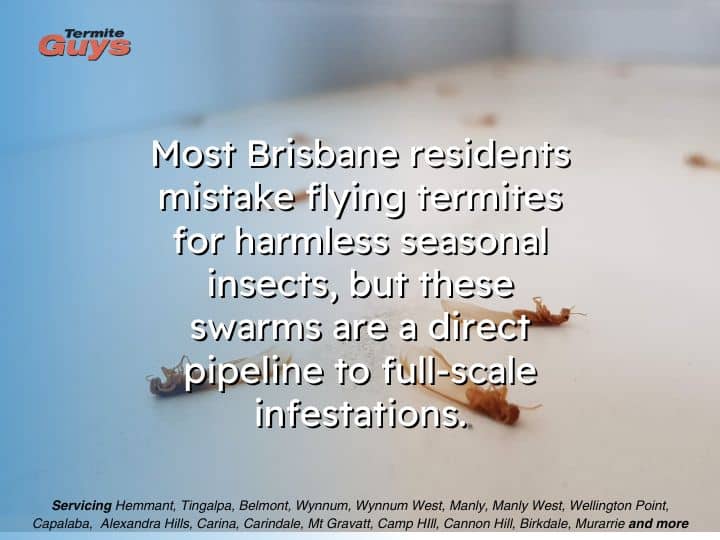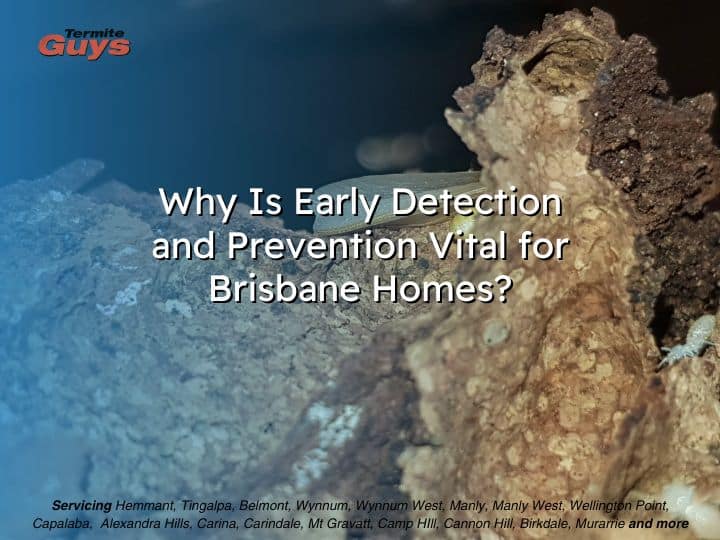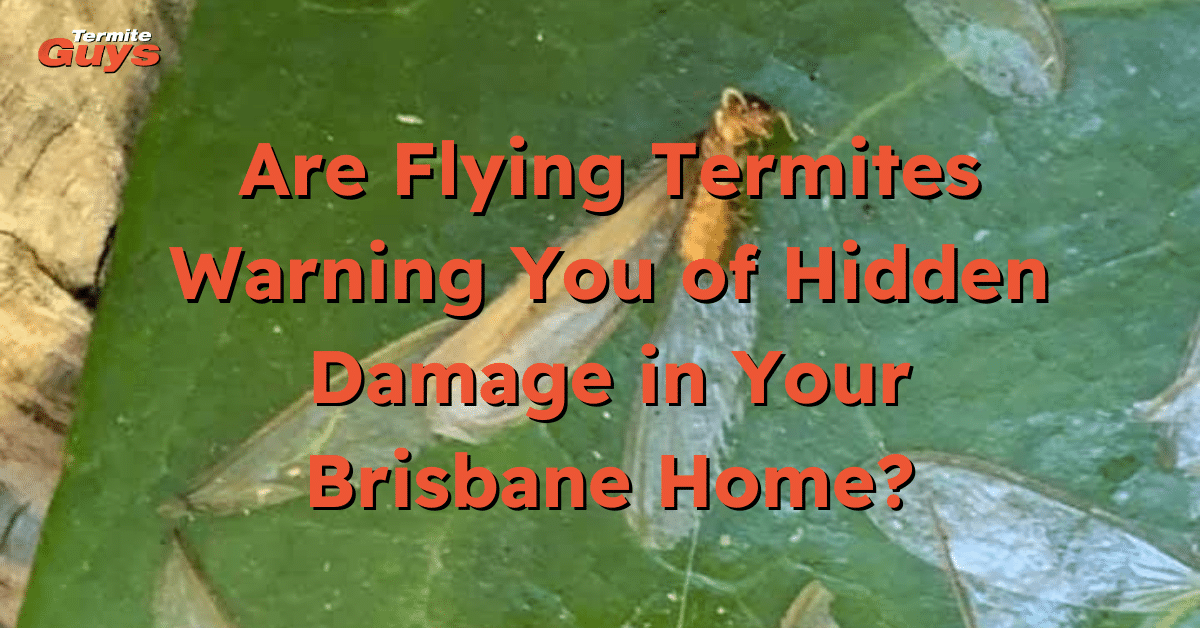Flying termites buzzing around Brisbane homes are more than just a seasonal nuisance – they’re an urgent signal that significant property risk is looming nearby. Homeowners across Queensland need to recognise this early warning: seeing these winged invaders often means a mature, hungry colony is on the attack or ready to build one, making rapid action essential to protect your home, finances, and long-term peace of mind.
Presence of flying termites indicates a nearby established colony.
Brisbane’s warm, humid climate makes termite swarms highly likely from November to March.
Early detection and specialist intervention are key to preventing structural loss.
If you see termites swarming in Brisbane during October or November, it’s a serious warning sign that a nest is nearby. Flying termites are nature’s way of telling you your home could soon be at risk. The best prevention is installing a professional termite barrier to keep them out. That’s why calling Termite Guys Brisbane is so important. Don’t wait until damage occurs—act now. Call 07-3393-3515 or email admin@termiteguys.com.au
What Does Seeing Flying Termites Around My Home Actually Mean?
Spotting flying termites – also known as alates – signals much more than passing insect activity. In most cases, swarms near your home in Brisbane reveal a well-developed termite colony either nesting in, under, or dangerously close to your property. These winged termites have one mission: to mate and establish new colonies, rapidly multiplying your risk.
When alates appear, it’s because their original colony has matured and is looking to expand. Even if you don’t see physical damage yet, their flight is a red alert for potential structural trouble:
Flying termites are reproductive caste members, ready to start new colonies.
Swarming often follows rain or high-humidity storm events around Brisbane.
Each swarm could mean hundreds of new colonies forming, especially in damp or unprotected homes.
Their presence indoors nearly always means a mature termite nest is close by.
Signs indicating termite activity
Alate swarms peak after storms and during hot, moist months.
Indicates a mature colony within flying distance (often on or under the property).
Unchecked, leads to rapid, costly damage to timber, flooring, beams, and stumps.
Dropped wings near windows or lights signal termite entry attempts.
Both new and older Brisbane homes are at proven risk due to local conditions.
Question related to termite activity
Q: Do flying termites mean there’s a nest in my house?
A: Spotting flying termites indoors is a strong sign there’s already a mature nest on or very close to your property. The swarming activity means the colony is ready to expand, rapidly increasing your risk of costly damage.
Q: How soon after seeing flying termites should I act?
A: Immediate action is recommended. Call a professional inspection service without delay to identify and treat the colony, as structural damage can accelerate within months or even weeks in Brisbane’s climate.
How Are Flying Termites Linked to Serious Active Infestations?
Most Brisbane residents mistake flying termites for harmless seasonal insects, but these swarms are a direct pipeline to full-scale infestations. Alates are the reproductive force behind new termite outbreaks. If you see them inside or around windows and lights, the original colony is typically large and thriving – a red flag that real, hidden damage is underway.
Once they land, alates shed their wings and look for wood in moist locations, such as behind walls, under floors, or around untreated stumps – foundations common to many older and newer Brisbane homes.
The colony multiplies quietly, often for months, before visible damage appears.

Flying termite sightings almost always correlate with existing mature colony activity.
Only reproductive termites fly – worker and soldier termites stay hidden, active, and destructive.
Once alates establish, new colonies can form within days after swarming events, especially in unprotected wood or damp areas.
Main colony may already be causing structural destruction before swarming is seen.
What to look out for:
Indoor sightings suggest termites have breached external and internal entry points.
Dropped wings, mud tubes, or frass near windows, lights, and timber signal active invasion.
Infestations stay hidden in wall cavities, under floors, or behind cabinetry for months.
New colonies can start soon after rainfall makes wooden stumps or beams damp.
Structural compromise builds up silently, without obvious warning until major damage occurs.
Related Questions
Q: Why do I find termite wings inside my house?
A: Termite wings indoors are evidence that flying termites have shed them after entering and attempting to start a new colony in your home’s timber or foundation areas. Their presence points to a critical active infestation risk.
Q: When do termites swarm in Brisbane?
A: Termite swarms in Brisbane generally occur after storms or during hot, humid weather, especially from November to March. This is when alates seek new sites to establish colonies, and infestation risks spike dramatically
What Kinds of Structural Damage Do Termites Cause Inside Brisbane Homes?
Termite attacks weaken homes from the inside out, often before any surface clues reveal the threat. Most damage starts in places hard to inspect—timber stumps, floor joists, hidden wall frames—and can involve:
Termites hollow out the inside of timber structures, feeding on the cellulose and leaving only a thin veneer of wood. The longer an infestation goes undetected, the greater the risk of severe damage and costly repairs.
Bearing walls, stumps, and flooring supports are common targets.
Some species destroy moisture-rich areas first (bathrooms, laundries, kitchens).
Visible signs include drooping floors, hollow-sounding wood, paint blisters, and tight doors or windows.
Hidden damages often cause floors to sag, frames to warp, and can even make homes unsafe.
Types of damage caused by termite activity:
Floorboards and timber supports may collapse quickly if left untreated.
Wall frames and roof trusses can weaken, putting the entire house at risk.
Subterranean termites bypass external barriers by building mud tubes up stumps and piers.
Hidden infestations can lower home resale value and curb appeal.
Untreated, termites can cost homeowners thousands in repairs.
Questions related to termite activity
Q: What signs of termite damage should I look for?
A: Look for hollow or soft-sounding wood, blistered paint, sagging floors, holes in timber, and piles of wings or frass. These are tell-tale signs that termites are attacking your home’s structure from within.
Q: Can termites really destroy a house?
A: Yes—especially in Brisbane conditions, where structural beams, stumps, and joists can be hollowed out within a year if infestations go undetected, sometimes making the home uninhabitable.
Why Is Early Detection and Prevention Vital for Brisbane Homes?
Because termite damage builds up before surface clues appear, waiting to see visible warning signs is a costly mistake. Annual professional inspections are essential for early detection and are the most effective way to prevent devastating losses to homes in high-risk areas like Brisbane.
Modern inspection techniques spot infestations in their infancy, long before outward symptoms or damage appear.
Preventative solutions, such as soil treatments, monitoring stations, and barrier systems, keep termites out and catch problems before they become expensive disasters

Early professional detection reduces repair costs and stops colony spread.
Preventative maintenance is far cheaper than repairing structural loss.
Brisbane’s unique climate demands localised, specialist termite protection.
Insurance rarely covers termite damage – prevention is your financial safeguard.
Early detection tips:
Annual termite inspections are non-negotiable for Queensland homes.
Early detection allows for targeted, low-impact treatments.
Soil, chemical, or physical barriers stop colonies entering from the environment.
DIY efforts are often unreliable compared to professional systems.
Ignoring the risk leads to escalating repair bills and potential home instability.
Questions related to timely detection
Q: How often should I get a professional termite inspection in Brisbane?
A: An annual professional termite inspection is recommended for all homes in Brisbane. High-risk or previously infested properties may require more frequent assessments to ensure early detection and effective prevention.
Q: Can I prevent termite infestations myself?
A: While homeowners can reduce risk by removing wood debris and fixing leaks, professional inspections and barriers provide far more effective and comprehensive protection against termite invasion in Brisbane.
FAQs
1. What attracts flying termites to my Brisbane property?
Flying termites are drawn to lights, moisture-rich wood, untreated stumps, and places with easy entry points. Brisbane’s climate and common home construction features make many properties attractive targets.
2. How long does it take for termites to cause major structural damage?
In Brisbane, termites can compromise major structural elements in as little as 6–12 months if left undetected, particularly in older or previously untreated homes.
3. Are flying termites different from flying ants?
Yes – while they look similar, flying termites have straight antennae, equal-length wings, and a thicker waist compared to flying ants’ elbowed antennae, unequal wings, and pinched waist.
4. Why aren’t termite problems covered by most insurance?
Insurers see termite protection as a maintenance responsibility, not an accidental event. Most policies exclude termite-related losses, stressing the importance of ongoing inspections.
5. What should I do if I spot flying termites in my home?
Do not disturb the area. Contact a qualified termite specialist immediately to assess and treat the situation before the infestation spreads or worsens
Summary:
Flying Termite Risks and Damage are a reality for every Brisbane homeowner.
Fast action – by calling Termite Guys Brisbane – ensures expert inspection and controls, keeping your home protected, structurally sound, and free from the costly devastation termites cause


